Centauri Dreams
Imagining and Planning Interstellar Exploration
A New Neptunian Trojan
It’s almost exhilarating to find that the volume of space studied in new work on the Trojan asteroids near Neptune includes an area through which New Horizons will pass on its way to Pluto/Charon. This used to seem like an all but unknowable region until Voyager 2 made its Neptune pass, and although it’s been a long time since we’ve had a spacecraft there, we’re learning much more about the outer system from Earth-based resources, as the discovery of objects like Eris and Sedna makes clear. We can surely look forward to more surprises as New Horizons moves toward its 2015 flyby and pushes on into the Kuiper Belt.
The latest find, based on data from the Subaru Telescope in Hawaii and the Magellan telescopes in Chile, is the first Trojan asteroid found at Neptune’s L5 Lagrangian point. Both the L4 and L5 Lagrangian points, 60 degrees ahead of and behind the planet, are stable, meaning that objects tend to collect there over time. Six Neptune Trojans are known in the L4 region, but until now the L5 point was hard to study because from our vantage on Earth, the line of sight is near the center of the galaxy. That called for a strategy using places where galactic dust clouds black out background light, revealing foreground asteroids. The result was the object called 2008 LC18.
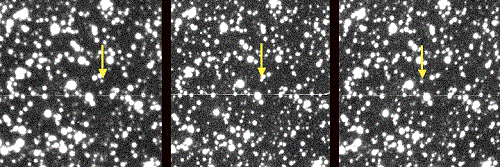
Image: Discovery images of the L5 trailing Neptune Trojan 2008 LC18, taken at the Subaru telescope on June 7, 2008 Universal Time. The Neptune Trojan is seen moving from right to left near the center of the image. Each image is separated by about one hour in time. The background stars are stationary. This image only shows about 1 percent of the area of one image from the telescope. Credit: Scott Sheppard/Chad Trujillo.
Scott Sheppard (Gemini Observatory), explains the result:
“We estimate that the new Neptune Trojan has a diameter of about 100 kilometers and that there are about 150 Neptune Trojans of similar size at L5. It matches the population estimates for the L4 Neptune stability region. This makes 100-km-wide Neptune Trojans more numerous than similar-sized bodies in the main asteroid belt between Mars and Jupiter. There are fewer Neptune Trojans known simply because they are very faint since they are so far from the Earth and Sun.”
So now we’ve identified another Trojan population linked to Neptune to join the L4 asteroids there and the Trojans associated with Jupiter. The objects are useful adjuncts to planet formation theories. In this case, the fact that 2008 LC18 has an orbit that is highly tilted to the plane of the Solar System parallels the similar orbits of some L4 Trojans, and suggests the objects were captured during the early years of the Solar System, when Neptune itself was moving in a different orbit than today. We have much to learn about planetary migration as the giant planets refined their orbits and a chaotic system gradually settled into place.
The paper is Sheppard and Trujillo, “Detection of a Trailing (L5) Neptune Trojan,” published online in Science Express August 12, 2010 (abstract).

Hoop Sails: An Interstellar Possibility?
When engineer Carl Wiley brought solar sails to a wide audience in 1951, he envisioned a particular kind of sail. Wiley, who wrote under the byline Russell Saunders, published “Clipper Ships of Space” in the May issue of Astounding Science Fiction that year, seven years before the first technical paper on sails, Richard Garwin’s “Solar Sailing: A Practical Method of Propulsion within the Solar System,” appeared in the journal Jet Propulsion. As you can see in the illustration, which ran with the original essay in Astounding, Wiley envisioned the sail as taking a parachute shape, with the payload attached to the sail circumference.

Varieties of Sail Design
But there are many ways of doing sails. Square or rectangular sail designs (think of those images of IKAROS shot by its detached cameras) have been the focus of recent work, with the result that many alternatives have not reached the same level of technological readiness. But along with parachute sails, spinning disk sails, ‘heliogyro’ designs and a variety of inflated sail concepts are all in the running for future development. Gregory Matloff (New York City College of Technology, CUNY) discussed the ‘hoop’ sail concept at the recent 2nd International Symposium on Solar Sailing, a study available in the proceedings.
A hoop sail is a disc-type sail attached to an inflatable rim, as in the diagram below. A payload could be distributed and hung from the hoop, with the advantage that no cables are necessary (contrast this with the extensive cabling of parachute-like designs), making the sail far easier to deploy. As opposed to other inflatable sail concepts, hoop sails are much less massive because they have only one surface, and present less surface area than other inflatable, hollow-body sails that could be endangered by micrometeorites — remember, the inflated rim is the only part of the sail that would use fill gas.
Hoop sails have made only a scant appearance in the technical literature, but going back through Matloff’s Deep Space Probes (Springer, 2000), I discovered in its 2nd edition that what work has been done has shown that a hoop sail structure is less massive than a square or rectangular boom supporting a sail’s cross members. Matloff quotes Colin McInnes from his 1999 book Solar Sailing (Springer-Praxis, 1999) on the growth of the overall sail concept:
Since Garwin’s paper initiated modern developments in solar sailing some forty years ago, the concept has inspired many individuals to devote their time and energy to advance the field. Countless technical papers have been written which demonstrate the potential advantages of solar sailing, many by graduate students who then move on to the more immediate problems of industry. Studies have been conducted which demonstrate the technical feasibility of solar sailing. However, for all these sometimes heroic efforts, an operational solar sail has yet to fly.
That’s a digression, but I had to include it to revel once again in the fact that the final sentence is no longer true, now that IKAROS is sending back data on sail performance every day. We can now look forward to trying out a variety of sail concepts as the idea is validated.
The Hoop Sail in Deep Space
But back to the hoop sail. Matloff’s continuing work on the concept has included an Oort Cloud Explorer (discussed in the appendix of Deep Space Probes), a sail 681 meters in diameter in which steering and attitude control would be provided by four smaller, five-meter hoop sails. Changing direction and attitude is an interesting issue, and it’s fascinating to consider how JAXA’s IKAROS team is experimenting with LCD units that allow the reflectivity of parts of the sail to be changed to achieve the same effects sought by the small adjunct sails that Matloff describes.
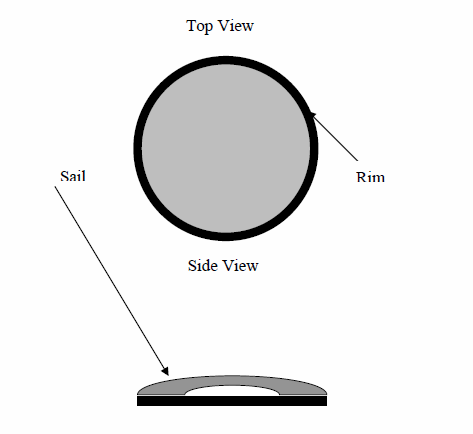
Image: Diagram of the hoop sail, of potential interest for deep space concepts. Credit: Gregory Matloff.
Massaging the numbers for a hoop sail to deep space, Matloff comes up with a ‘sundiver’ trajectory that allows a hoop sail spacecraft to exit the Solar System at about 635 kilometers per second (130 AU per year). This is sufficient to reach the inner fringe of the Oort Cloud in several decades, while a crossing to the Centauri system would involve 2,000 years. That’s about twice the time for an optimized mission with a space-manufactured sail.
Thus the limitation of the hoop sail, in the fact that it has perhaps 50 percent of the performance of the ultimate space-manufactured sails Matloff considers in the same volume. But as his presentation at ISSS 2010 shows, this configuration has undeniable advantages that are worth further study. Matloff goes into sail materials — beryllium seems the best candidate — and he considers a 40 nm beryllium sail to be near optimum. He assumes a rim and sail constructed of the same material, with the rim as an inflated torus with an internal fill gas. The payload is then suspended from the torus in equi-spaced sections so that pressure on the rim is uniform.
Sorting Out Known Issues
One problem, and a huge one, with sundiver missions is the temperatures involved. Assuming a perihelion of 0.07 AU, we can produce the 635 kilometers per second to reach Centauri A in 2000 years, but Matloff notes that in earlier work, 40 nm beryllium is found to become transparent at such temperatures. He juggles increased sail thickness and works with different perihelion distances to lower the sail temperature, finding decreased cruise velocity using such methods, with the Centauri journey extended to roughly 2900 years.
And then there’s this not inconsiderable problem:
Pushed by solar-radiation pressure, the sail membrane within the hoop, like the parachute sail, will in some ways resemble a soap bubble. It is not impossible that micrometeoroid impact punctures could rupture the sail. To prevent this, the sail could push against a network of fine carbon filaments that would serve as a ripstop.
Such a system seems to work and exacts no showstopping mass issues, leaving the hoop sail competitive with other interstellar sail configurations. We’re left with real advantages in scalability and ease of deployment even as the ripstop array increases total spacecraft mass by only a few percent. Thus a sail shaped like the rim of a bicycle wheel with the sail film inside the hoop emerges as an interesting design contender, one that could be used for ultra-thin film sails launched from Earth rather than being manufactured in space.
Matloff presents an interesting early application in Deep Space Probes, a lunar orbital or impact mission using multiple connected hoop sails, the central sail supporting the outer ones, which would be used for guidance and control, with payload suspended from the center of the central hoop. This one is low in mass, and relatively simple to stow and deploy. Such a mission could be a useful demonstrator of the concept, but we have a long way to go if we’re talking deep space. As the author notes in his ISSS 2010 presentation: “The work presented here should be viewed as a very preliminary analysis. Much additional research is required before interstellar hoop sails can be declared feasible.”
The presentation is “The Hoop Solar-Photon Sail and Extrasolar Travel,” available in the proceedings of the 2nd International Symposium on Solar Sailing. It’s interesting, too, to compare this work with a paper Matloff did on a different inflatable sail concept with sail experts Roman Kezerashvili, Claudio Maccone and Les Johnson back in 2008. It’s “The beryllium hollow-body solar sail: exploration of the Sun’s gravitational focus and the inner Oort Cloud” (preprint).

The Perseid Project: Crowd-sourcing the Meteor Stream
An individual meteorite can tell us much about the composition of ancient Solar System material, but today I want to mention a project that is taking the aggregate view. Chris Crawford has set up the Perseid Laptop Meteor Observation Project as a way to use ‘crowd-sourcing’ to build up a three-dimensional map of the Perseid meteor stream. Here’s what Chris said about it in a recent email:
This will be one of the better years for Perseids; the Moon, which often interferes with the Perseids, will not be a problem this year. So I’m putting together something that’s never been done before: a spatial analysis of the Perseid meteor stream. We’ve had plenty of temporal analyses, but nobody has ever been able to get data over a wide area — because observations have always been localized to single observers. But what if we had hundreds or thousands of people all over North America and Europe observing Perseids and somebody collected and collated all their observations? This is crowd-sourcing applied to meteor astronomy.
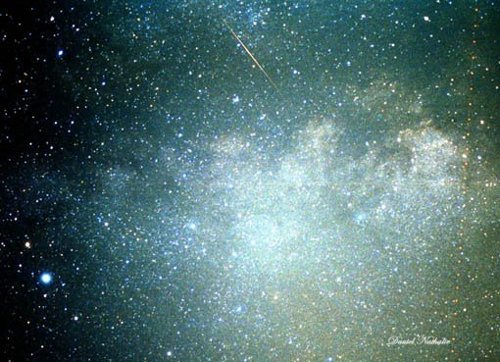
The Perseid program is available at the project site and it’s simple enough to use. On the night of Wednesday-Thursday, August 11-12, you take your laptop outside and launch the program, clicking the mouse every time you see a meteor. The next day, enter your latitude and longitude into the log file and send off the data. Do note this geographical restriction: You must be in the northern hemisphere to see the Perseids; the further north, the better.
Image: This August 12th Perseid meteor (upper middle) is streaking by the blue star Altair (lower left). Photo details: 50 mm lens f/1.7, 10 minutes exposure on Kodak 800 ASA film. Credit: Dautel Nathalie.
As to the Perseids themselves, this meteor shower gets its name because the meteors, from our vantage, seem to emanate from the constellation Perseus. The Perseid cloud follows the orbit of comet Swift-Tuttle, and evidently is made up of cometary material ejected during the comet’s 130-year orbit. The Perseids have quite a history, having been observed for 2000 years, with peak activity reaching 60 meteors or more per hour. Look for the highest rate of activity in the pre-dawn hours. This year, as Chris notes, should offer excellent viewing, and hence a good chance to shake out his software.
Usually I write about celestial debris in the context of the clues it can offer up to astrobiology, or as examples of the need to develop the technologies to fend off larger objects like asteroids. But a fascinating outgrowth of our ever more powerful desktop technologies is the ability to put in just a small amount of time to achieve a widely distributed result, one that looks at a natural phenomenon in a new way. Here’s to the success of the Perseid Project, with the hope that it’s a forerunner of future skywatch collaborations.

Adaptive Optics and the Giant Magellan Telescope
Anything we can do to advance the cause of adaptive optics is all to the good. It’s obvious that a space-based observatory is preferable if we want to get the sharpest look at a distant object, but launch costs are still high and the kind of intricate interferometry missions that will one day let us take a close look at a distant exoplanet are still on the drawing boards. In the interim, learning how to get around the distortion caused by a planetary atmosphere allows us to do things with Earth-based telescopes that earlier astronomers wouldn’t have thought possible.
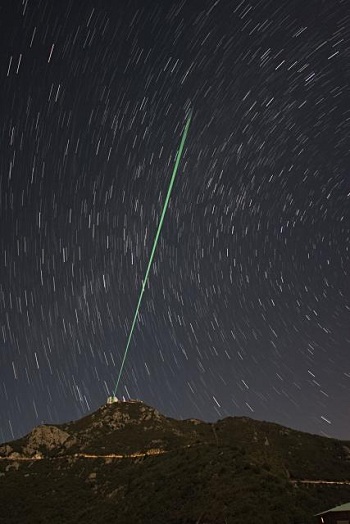
The kind of laser adaptive optics in use at the University of Arizona represents a useful advance in the state of the art. Make a telescope mirror pliable enough to respond to hundreds of actuators positioned on its back side and you can create a series of tiny adjustments as you look at the sky. The adjustments are necessary because atmospheric turbulence blurs the image, the result of rising heat disturbing the air a few thousand feet above our heads. Astronomers use a laser beam to create an artificial ‘star’ that gives them data about the turbulence. All of that information then goes into the computer that controls the mirror.
Image: A bundle of laser beams creates five artificial stars in the night sky above Mount Hopkins in Southern Arizona. Laser light reflected by air molecules is analyzed by a computer that drives the actuators on the adaptive mirror. (Image courtesy of Thomas Stalcup).
In the case of the work being done at Arizona by Michael Hart and team, there is not one laser ‘star’ but five. The 336 actuators on the back side of their telescope’s adaptive mirror smoothly alter its shape thousands of times each second. While techniques like these have grown increasingly sophisticated over the past two decades, Hart’s work is extending adaptive optics to a broader field of view. Until now, atmospheric blurring could only be canceled along a relatively narrow line of sight. Hart loses a bit of resolution to gain the larger field of view.
The result: The oldest galaxies, formed around ten billion years ago, become more susceptible to study. Hart says the new technique extends the range of observation:
“To understand the evolution of those ancient galaxies, we have to observe thousands of them and study their spectral characteristics and chemical composition, and taking a spectrum of a high red-shift galaxy takes a long time because they are so faint… With our new adaptive optics technique, you can now observe dozens at a time. Sampling thousands of galaxies’ spectra becomes feasible.”
Where next for adaptive optics? The current work allows cancelation of atmospheric turbulence over a field of two arc minutes (one-fifteenth of a full moon). Extending it to future instruments like the Giant Magellan Telescope should push its boundaries much further. The GMT is scheduled for completion in 2018, using a 24.5-meter primary mirror with adaptive optics that should be capable of producing images up to ten times sharper than those taken by the Hubble Space Telescope. Its uses in exoplanet discovery and observation, in addition to its other duties in astrophysics, should make it a potent competitor to space-based systems as we develop the skills and resources for the latter to take the next big step.
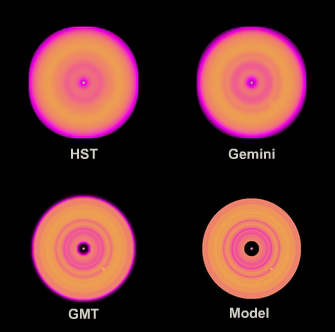
Will the GMT be able to see Earth-analogues around other stars? We know how tricky this will be. A planet of Jupiter’s size and orbit reflects only 10-9 of its star’s visual light, while a planet like Earth reflects only 10-10 of that light. But have a look at the image, which shows a young protoplanetary disk with embedded planet. A newly formed terrestrial planet at 1 AU is molten, with a temperature of 1500 K, its thermal emission capable of being detected in the mid-infrared range until the planet cools to the point where it becomes undetectable. As for intermediate age stars (around a billion years old), the GMT Science Case makes this point:
A survey of 100 intermediate age (~1 Gyr) stars within 10pc is likely to yield dozens of massive planets at larger radii than those probed by the radial velocity surveys. The Webb telescope will also be a powerful tool for addressing this issue, but the superior resolving power of the GMT will allow it to probe to larger distances and smaller orbital diameters.
Image: A model calculation of an evolving protoplanetary disk with an age of 30 million years as imaged with a perfect telescope (lower right), the Hubble Space Telescope, the Gemini 8m and the GMT, the latter two operating with extreme AO at 1.65μm. The GMT image reveals gaps and other structure in the disk, as well as the terrestrial mass protoplanet. Credit: GMT Consortium.
Adaptive optics working with an instrument like the GMT is suited for many more tasks than exoplanet hunting, of course, including investigations into the properties of dark matter and dark energy. What we’ve learned by building new instruments and extending the powers of those we already have, though, is that many of the discoveries they go on to make are utterly unanticipated by their builders. We can assume the same result from the new generation of AO-augmented telescopes that will so sharply increase the quality of Earth-based observation.

Project Argus: Finding a ‘Benford Beacon’
It’s heartening to see James and Gregory Benford’s work on extraterrestrial beacons receiving broader coverage. We’ve looked at the relevant papers in these pages [run a search on ‘Benford’ in our database and you’ll pull up articles by and about them], but news features like this one in TIME Magazine are pushing the Benford brothers’ work out to a much larger audience. That’s an important step, because right now the view of SETI most likely held by the average person relates to movies like Contact, in which huge dishes pointed at particular stars seem to be the way to proceed. The Benfords want to re-write that scenario in a big way.
We’ll have to leave as debatable the question about how far away our own television transmissions can be received. James Benford commented here not long ago that a civilization of approximately our technological level would not be able to receive broadcast signals as weak as those we’ve sent out carrying the likes of Milton Berle and I Love Lucy. Presumably, a far superior civilization could find those signals, but the question for our SETI search is, what kind of signal is feasible for us to receive today, and where do we look?
Economics of the ‘Short Burst’
I like the notion of applying economics to this issue, which is what the Benfords do in analyzing how cost-effective an interstellar transmission strategy would be for the civilization sending it. It turns out that short, powerful bursts sent out now and then are far more reasonable than continuous broadcasts, given the realities of energy usage on the interstellar level. We’re a lot less likely to find such ‘Benford beacons’ if we aren’t pointed at just the right place at just the right time. Could the 1970s-era ‘Wow’ signal have been a Benford beacon, one we lacked the resources to follow up on with sufficient rigor to track down its true nature?
Whatever it was, the ‘Wow’ signal stands as a reminder that there’s a lot we aren’t doing. Gregory Benford told TIME that adding up all the SETI observing time over the past half century yields only a few months of data. So what would the chances be of finding a sporadic burst given the listening time and strategies involved? All of which gets me to Project Argus, an inspiring attempt by the SETI League to enlist the service of amateurs in the cause of broadening SETI’s reach. The ambitious goal is to deploy 5,000 small radio telescopes around the globe, providing what the SETI League calls ‘the first ever continuous monitoring of the entire sky, in all directions in real time.’ From the SETI League:
Traditional research grade radio telescopes (the type which NASA used) can view only a small fraction of the sky at a given time, typically on the order of one part in a million. All-sky coverage with these instruments would thus require a million telescopes, properly aimed. At a cost of perhaps one hundred million US dollars apiece, such a network would exceed the Gross Planetary Product. Fortunately, there is another way.
Project Argus On the Case
That other way involves amateurs putting up to a few thousand dollars into an amateur radio telescope capable of the microwave coverage Project Argus demands. What you get with 5,000 small telescopes is full-sky coverage with the ability to pick up microwave radiation from a technologically advanced civilization out to several hundred light years. In a recent post on a mailing list of space professionals, writer David Brin noted that targeted signals like those sent to other stars from the Evpatoria radio telescope in the Crimea would probably not be detectable by an Allen Telescope Array, whereas a Project Argus at full strength would have found them.
Paul Shuch, executive director emeritus of the SETI League, is well aware that Project Argus will have to grow from its current 150 or so installations to the requisite 5000 to be truly operational, but perhaps this is where a philanthropist with a SETI bent could make a difference. In any event, what Project Argus is doing is of so fundamentally different a nature than the SETI Institute’s work that it’s deserving of our support. A combination of approaches is all to the good, and Project Argus adds a component than in Benford terms is more likely to succeed. Here’s Paul Shuch on the matter in a recent SETI League editorial:
Both the SETI League and the SETI Institute are committed to furthering SETI science. For the past several years, the SETI Institute has spearheaded the design, development, construction, and operation of the Allen Telescope Array, clearly the world’s most advanced SETI research instrument. The SETI League takes a different tack, encouraging the construction of hundreds of small, low-cost amateur radio telescopes around the world. In years past, the SETI Institute has conducted a powerful targeted search of nearby sun-like stars, while the SETI League has concentrated on a significantly less sensitive all-sky survey, in hopes of detecting those very powerful, yet highly intermittent, signals which might well evade a more sensitive, targeted search.
So on with the Allen Telescope Array, but kudos as well to the hard-working SETI League and its attempt to set up the kind of observational effort that just might detect the next ‘Wow’ signal. We should also keep in mind the other Benford caveats, that the obvious direction to look is toward the center of the Milky Way, where civilizations around older stars might have a more advanced technology and might have chosen to deploy a beacon along the galaxy’s radius. Short, powerful bursts are going to be tricky to catch, so the more eyes and ears on the case, the greater the chances of success. Project Argus is an apt name. The mythical Argus had 100 eyes and could see in all directions at once, perhaps just the ticket for finding another civilization.

Pegging the Movements of a Potential Impactor
NASA’s workshop on identifying objectives for missions to near-Earth objects will be held next week, August 10-11 at the Renaissance Mayflower Hotel in Washington, DC. We can hope that this gathering of NASA leaders, academics, and space experts from across the international community will help keep the public’s attention on the need for such missions. Part of the reason for having the workshop is to communicate NASA’s preliminary plans for a human mission to an NEO, a useful step as we build expertise about these objects and ponder strategies to handle any future impact scenarios. You can follow the video stream at the appropriate time here.
Meanwhile, the continuing survey of near-Earth objects has produced another one, asteroid 101955 1999 RQ36, with a slight impact possibility in 2182. We can call this object a Potentially Hazardous Asteroid (PHA) based on the results from the two mathematical models — Monte Carlo Method and line of variations sampling — being used to study it. The object was discovered in 1999 and is about 560 meters in diameter. You would think that after 290 optical observations and thirteen radar measurements, the orbit of this asteroid would be well understood, but complicating the matter is the so-called Yarkovsky effect.
Russian civil engineer Ivan Yarkovsky (1844-1902) noted the eponymous effect by studying how rotating objects in space experience thermal changes over time. He realized that their orbits can be modified because a rotating small object heats unevenly. The Estonian astronomer Ernst Öpik applied Yarkovsky’s ideas to small objects like meteoroids in the Solar System, and the effect was first measured (1991-2003) on the asteroid 6489 Golevka, which was observed to have moved 15 kilometers from its predicted position over twelve years of observations. Because the effect depends on size, it can be significant on smaller asteroids and negligible on larger ones.
Even so, over the course of time, asteroids can be perturbed enough to move out of the main belt and into the inner system. The problem is that the Yarkovsky effect on a particular asteroid can be hard to predict because of variables like the asteroid’s shape and albedo. Moreover, a close approach to the Earth can modify the orbit so that, in the words of the paper on this work, “…the problem becomes like that of a newly discovered asteroid with a weakly determined orbit.” A close pass, in other words, can confound what had been a precisely determined orbit.
María Eugenia Sansaturio (University of Valladolid), co-author of a paper on 1999 RQ36 that ran last year, explains that the object’s projected movement can only be measured in probabilities:
“The total impact probability of asteroid ‘(101955) 1999 RQ36’ can be estimated in 0.00092 – approximately one-in-a-thousand chance-, but what is most surprising is that over half of this chance (0.00054) corresponds to 2182.”
But what is more telling is the scientist’s take on our chances of deflecting such an asteroid. The research, published in Icarus, notes that the object approaches the Earth between 2060 and 2080, making another approach in 2162 and another in 2182, deemed the most likely year for a collision if one is going to occur. If moving an asteroid is the objective, the longer the lead time, the better:
“The consequence of this complex dynamic is not just the likelihood of a comparatively large impact, but also that a realistic deflection procedure (path deviation) could only be made before the impact in 2080, and more easily, before 2060… If this object had been discovered after 2080, the deflection would require a technology that is not currently available. Therefore, this example suggests that impact monitoring, which up to date does not cover more than 80 or 100 years, may need to encompass more than one century. Thus, the efforts to deviate this type of objects could be conducted with moderate resources, from a technological and financial point of view.”
I take that last sentence to mean that it will be cheaper and more within the range of our near-term technology to deflect an object whose orbit is determined to be dangerous if we have a century or more to prepare. The necessary refinements of orbital calculations continue during this period, allowing us to rule out the impact possibity altogether or to study the object further if the odds on a strike increase. Continued attention to maintaining facilities like Arecibo, whose planetary radar can help us track such objects, should be a paramount part of our overall space policy.
The paper is Sansaturio et al., “Long term impact risk for (101955) 1999 RQ36,” published online in Icarus, Vol. 203, Issue 2 (October, 2009), pp. 460-471 (abstract / preprint).


